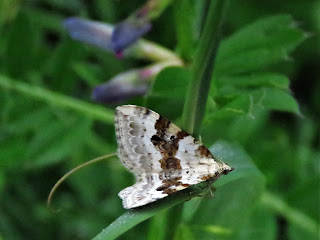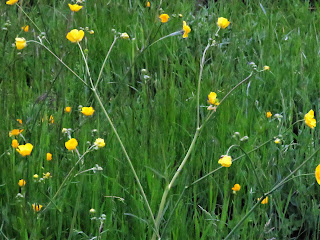8.5°C > 13.0°C: Overcast start, breaking after 08:45. Moderate ENE wind. Moderate visibility and rather hazy.
Sunrise: 05:01 BST
Priorslee Lake: 06:25 – 09:30
(57th visit of the year)
I arrived back yesterday after a 24-hour journey from Alaska, complete with a heavy head-cold so I was none too disposed for an early start this morning!
Two Common Terns present after 07:15 became my 86th species recorded here this year
Other notes from today:
- the ‘resident’ 6 Mute Swans still present: the long-term pair seem to have 4 cygnets only (they soon took them back to the nest). The pair in the NE area are still sitting – this seems rather too long? The non-nesting pair were still present
- one of the Great Crested Grebes was holdings its back-feathers as if it might be carrying juveniles: unconfirmed at the moment
- no Moorhens seen and no Coot juveniles – too windy?
- no Jackdaws or Rooks either: usually by this date they are ferrying food back and forth to distant nest sites
- more Reed Warblers now: one singing along the S side and another in the shrubs along the N side
- the Starling overhead was making the calls associated with fledged (or about to fledge) juveniles
and
- nothing on the lamps this morning
- a Silver-ground Carpet moth flushed from the vegetation
- also a Common Marble moth (Celypha lacunana): my earliest-ever date for this species
- several Common stretch-spiders (Tetragnatha extensa)
- a Red-and-Black Froghopper (Cercopis vulnerata)
- several Alder flies (likely Sialis lutaria) on the sluice entrance
- after the cloud cleared a few damselflies flew: specifically identified were both Common Blue and Azure Damselflies
I noted the following plants in flower (in no particular order)
- Daisy (Bellis perennis)
- Dandelion sp. (probably Taraxacum officinale)
- Creeping Buttercup (Ranunculus repens)
- Meadow Buttercup (Ranunculus acris)
- Hawkweed sp. (probably Hieraceum brittanicum)
- probably Common Sorrel (Rumex acetosa)
- Dog Rose (Rosa canina agg.)
- Ox-eye daisy (Leucanthemum vulgare)
- Common Forget-me-not (Myosotis arvensis)
- Blackberry (Rubus fruticosus agg.)
- Wood Avens (Geum urbanum)
- Black Meddick (Medicago lupulina)
- Rapeseed (Brassica napus) [rape; oilseed rape – field escape]
- Tufted Vetch (Vicia cracca)
- Yellow Flag (Iris pseudacorus)
- Cow Parsley (Anthriscus sylvestris)
- Hawthorn (Crataegus monogyna)
- White Dead-Nettle (Lamium album)
- Herb Robert (Geranium robertianum)
- Ramsons (Allium ursinum)
- Lady's Smock / Cuckooplant / Milkmaid (Cardamine pratensis) – a few remaining
- Hedge Garlic or Jack-by-the-Hedge (Alliaria petiolata) – a few remaining
- Red Clover (Trifolium pratense)
- Red Campion (Silene dioica or Melandrium rubrum)
- Dogwood (Cornus sanguinea) or Red Stem Dogwood (Cornus stolonifera)
- Alder Buckthorn (Frangula alnus)
- Yellow Archangel (Lamium galeobdolon)
- White Dead-Nettle (Lamium album)
- Common Hogweed (Heracleum sphondylium)
- Guelder Rose (Viburnum opulus)
Today’s bird totals
Birds noted flying over / near the lake:
- 2 Lesser Black-backed Gulls
- 2 Herring Gulls
- 3 Wood Pigeons only
- 1 Starling
Hirundines seen today
- 8 Common Swifts
- 2 Barn Swallows
Warblers noted: figure in brackets is singing birds (not all the males seen might have been singing)
- 6 (5) Chiffchaffs
- 14 (14) Blackcaps
- 2 (2) Garden Warblers
- 2 (2) (Common) Whitethroats
- 6 (5) Reed Warblers
The counts from the lake area
- 6 + 4 (1) Mute Swans
- 14 (12♂) Mallard
- 4 Great Crested Grebes
- no Moorhens
- 23 Coots
- 2 Common Terns
This is somewhat of a mystery. The flowers resemble those of both Medlar (Mespilus germanica) and Crab Apple (Malus sp.) but those are trees and the leaves are not right. Its behaviour growing low on the dam and shape of the leaves look somewhat like Small-leaved Cotoneaster (Cotoneaster microphyllus) – but not the flowers! Surprisingly, all these species are (or at least were) in the same general classification. I suspect it is likely a garden-escape stunted by growing on very impoverished soil, and possibly a cross anyway.
A flight shot shows that at certain angles the tail can appear very long – another feature of Arctic Tern, though often difficult to judge on a lone bird.
Another flight shot: there were two different birds present and this may be a different bird.
Last flying shot
Almost!
The long bill is well illustrated here.
A male Common Whitethroat rather ruffled in the breeze.
A Silver-ground Carpet moth: in the background we see Tufted Vetch (Vicia cracca) about to open.
A Common Marble (Celypha lacunana) moth lurking.
An Azure Damselfly with a narrow band on the thorax. Note it is rather hairy!
With a wide band on the thorax here is a Common Blue Damselfly.
The very caddis fly-looking Alder Fly (Sialis lutaria).
A Red-and-Black Froghopper (Cercopis vulnerata).
One of many banks of Cow Parsley (Anthriscus sylvestris).
Red Campion (Silene dioica or Melandrium rubrum).
Amongst all the Cow Parsley were a few Common Hogweed (Heracleum sphondylium) plants.
I am fairly certain these flowers are from a Wayfaring Tree (Viburnum lantana): often a planted shrub.
Another shrub in flower and probably planted - Guelder Rose (Viburnum opulus).
Hawkweeds are a minefield with many closely related species: this is probably Hieraceum brittanicum.
I’ll have to ‘pend’ this seed head: obviously closely-related to dandelion but ...?
Just opening are the first Yellow Flags (Iris pseudacorus).
Also just opening is this Ox-eye daisy (Leucanthemum vulgare).
A Dog Rose (Rosa canina agg.) flower.
Common Forget-me-not (Myosotis arvensis).
Well it is May as well time for Hawthorn or May (Crataegus monogyna) flowers.
Here is a flower-head of Ramsons (Allium ursinum).
In a ditch so I could not photo in to the flower of this White Dead-Nettle (Lamium album)
In the same ditch this closely-related Yellow Archangel (Lamium galeobdolon).
A White-lipped Snail (Cepaea hortensis)
Another.
(Ed Wilson)
------------------------------------------------------------------------------------------------------
On this day..........
2016Priorslee Lake
Today's Sightings Here
2015
Priorslee Lake
Today's Sightings Here
2006
Priorslee Lake
Mink seen by locals
(Ed Wilson)






































